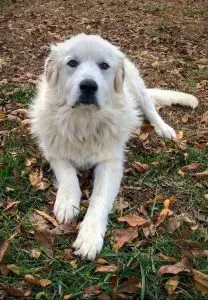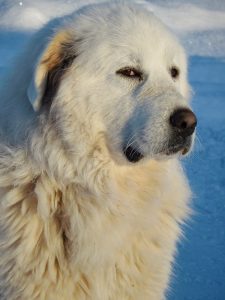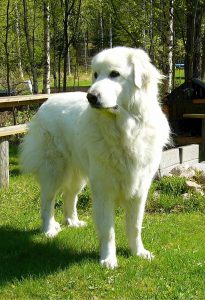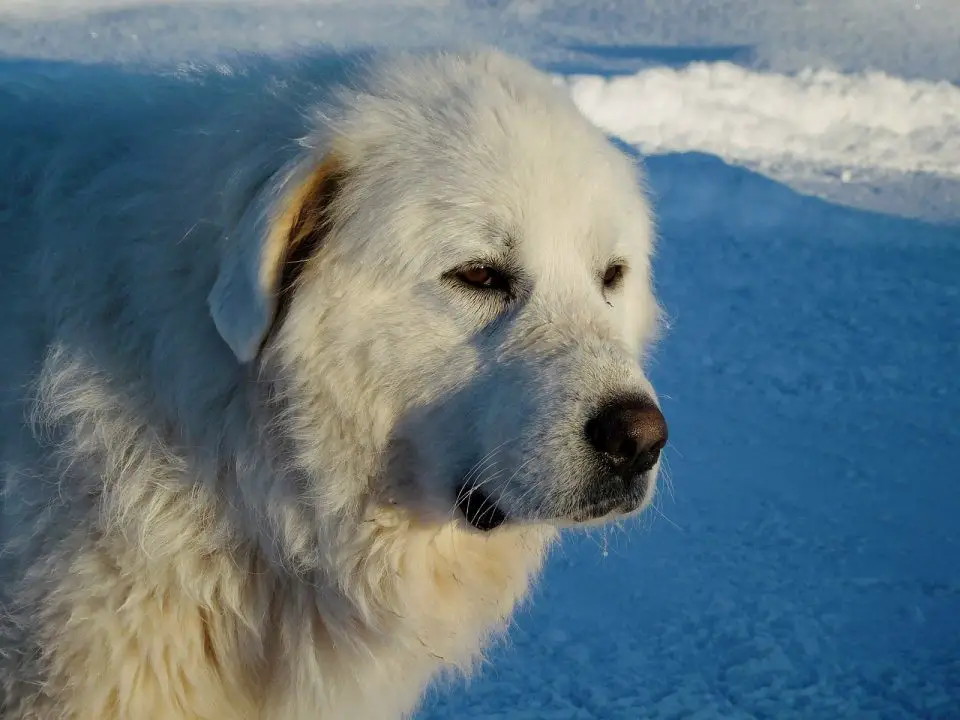Great Pyrenees are gentle giants who have rightly earned the title of majestic.
They are large – standing as high as 32 inches at the shoulder – but able to move with urgency and grace.They’re good companions and are a highly coveted breed.
However, due to concerns about shedding and allergies, deciding whether or not to adopt a Great Pyrenees to bring into your home can be a daunting task.
While you shouldn’t be afraid of the possibility, it’s important that you do your research on the Great Pyrenees so that you can fully understand their needs and, most importantly, their coat and how it works.
To do so, you should start at the very beginning with the Great Pyrenees’ history.
Short History of the Great Pyrenees
Just taking a quick look will tell you a lot about the history of the Great Pyrenees.
First, their large, bulky frame shows that they were bred for working, and their thick white fur gives away where they are from – snowy mountains.
While both of these things are true, there’s a bit more to the history of the Great Pyrenees.
The Great Pyrenees was bred in the Pyrenees Mountains between Spain and France where they acted as herd dogs, guard dogs, and loyal, loving companions.
While a lot of their origins are unknown due to the age of their breed, scientists have found their bones in deposits that are dated back to the Bronze Age, which ended over 3000 years ago.
The Great Pyrenees was officially registered with the American Kennel Club in 1885, and these lovable lion-like dogs have been stealing hearts ever since.
What is a Great Pyrenees’ Coat Like?
 In order to survive the harsh winters they were bred in, the Great Pyrenees has a weather resistant double coat.
In order to survive the harsh winters they were bred in, the Great Pyrenees has a weather resistant double coat.
The outer coat consists of thick,coarse hair that is straight and does not stand away from the body. The undercoat is dense and woolly.
The coat is thicker around your Great Pyrenees’ neck and shoulders, forming ruff or mane which, like the lions they resemble, is more pronounced in males.
The hair is longer on the tail, with feathering along the back of the legs, and the hair on your Great Pyrenees’ face and ears is shorter and finer.
Do Great Pyrenees Shed?
In short, yes.
It probably comes as no surprise that they shed, due to the amount of thick hair they have!
However, that brings up the next question, how much do they shed?
How Much do Great Pyrenees Shed?
Great Pyrenees shed a lot. In fact, one owner wrote to the American Kennel Club and said that a Great Pyrenees’ shedding “leads to a snowstorm.
They shed in the spring, after whelping, in honor of certain Druid festivals, and after you enter them in a show!”
While the American Kennel Club has them listed officially as seasonal shedders, you can expect to deal with at least minor shedding year round.
When do Great Pyrenees Shed the Most
While shedding is a year round occurrence for the Great Pyrenees, you will find occasions where they shed the most.
Time of year
Think of seasonal shedding as your Great Pyrenees getting their summer bod.
When the weather starts heating up, normally in the spring, your Great Pyrenees will experience a large coat blow out as they attempt to adapt to the temperatures.
While there isn’t much change in their coat, due to them being bred to live in the mountains year-round, their summer coat is slightly lighter, providing them just a little relief from the heat and sun.
A fall blow out is much less uncommon, with their coats simply thickening back up to prepare them for colder temperatures.
Puppy coat
As the quoted owner said before, Great Pyrenees will blow out their coat after they reach maturity, resulting in a snowstorm of Great Pyrenees fur.
As they grow older, the soft, wispy fur of their puppy coat won’t protect them as well, so they must adapt and grow a thicker one more suitable for adult life.
Health Issues that can Cause an Increase in Shedding in Your Great Pyrenees
 Not all shedding natural, though. Sometimes, health issues can cause your Great Pyrenees to experience an increase in shedding.
Not all shedding natural, though. Sometimes, health issues can cause your Great Pyrenees to experience an increase in shedding.
So it’s important to check with your vet if you notice an increase in hair around your home outside of either of the two natural causes listed above.
Poor diets
With the increase of cheap food on the market, poor diets are becoming more and more of a problem, especially with big dogs like the Great Pyrenees who eat much more than other smaller breeds.
Cheap food lacks the nutrients that dogs need, and they often are brimming with fillers and grains and by-products that are unhealthy for your dog.
After some time, a poor diet will take its toll on your dog, inside and out.
You’ll notice that they won’t be their best selves, and their coats will appear dull and limp. It’ll be more prone to breakage, and it’ll shed more.
Skin irritation
Skin irritation can be caused by a lot of things, but one of the most common causes is dry skin.
Dogs are just like humans, and sometimes they need a little bit of extra moisture for their skin, especially in extreme temperatures.
Investing in a lotion or moisturizing wash can help reduce shedding caused by this problem.
Allergies
Dogs suffer from allergies too, and, whether they are allergic to the shampoo you are washing them with or the bites of pests such as fleas, it can damage their skin and lead to hair loss.
If you suspect that allergies are the reason that your dog is shedding more often, make sure to talk to your vet about possible treatment plans.
Pests
Fleas and ticks can cause a lot of the problems listed above, such as skin irritation or allergic reactions.
While prevention using a flea collar or wash is the best thing you can do.
If you suspect that your dog already has a flea problem, make sure to handle it appropriately by talking to your vet. This should help reduce any shedding caused from irritation.
Parasites
Like fleas and ticks, parasites such as heartworms and tapeworms, can cause your dog to feel irritated or anxious, leading to excessive grooming to soothe themselves.
Over grooming can lead to bald spots and excessive shedding.
So, if you suspect that your dog has a parasite make sure to talk to your vet about a possible diagnosis and treatment plans to help your dog feel like him or herself again.
How to Combat Great Pyrenees Shedding
Regular grooming is really the only way to combat Great Pyrenees shedding. You see, due to their double coat, you cannot shave a Great Pyrenees.
The way their double coat is set up, shaving it can be detrimental. In fact, if you do shave it, you’ll find that there is a high possibility that your dog’s coat will never grow right again.
You will also leave them exposed to the elements. Rather than shaving their fur completely, try to groom it regularly.
Daily brushes with a slicker brush will help prevent most shedding as well as knots and mats.
Then, twice a week, do an extensive brushing routine using multiple tools like those discussed below. Finally, in the shedding season you can wash your dog every other week or so.
Otherwise, wash them once a month or so as frequent bathing can strip the coat of natural oils. Find a routine that works for you and your dog!
Equipment Help to Combat Great Pyrenees Shedding
Top 6 Brushes and Other Tools
1) Hertzko Self Cleaning Slicker Brush
A slicker brush will be your best friend when it comes to daily grooming.
This brush is self-cleaning and will remove dirt, debris, knots, and small mats from both the top coat and undercoat, helping prevent any significant issues from arising from a dirty coat.
It will also catch any loose hair, helping prevent hair that has already been shedding from ending up on your floor.
2) Pro Quality Self Cleaning Slicker Brush
While the steep price makes this brush a bit of a luxury item, it’s definitely well worth the cost.
It’s self-cleaning with gentle, flexible bristles that are tough on dirt, debris, knots, and mats. It has been recommended by users and professional groomers alike.
It also comes with both an ebook to help if it is your first time grooming a dog with a slicker brush as well as a lifetime warranty.
3) Pet Magasin Professional Grooming Brushes
This trio comes with the three brushes you will use almost on a day to day basis for your Great Pyrenees.
The brush helps remove anything from hair to dirt caught in the coats, while the dematting tools removes tough knots and mats, and the rake helps remove debris, dirt, and hair from deep within the undercoat.
It can be used on both large and small dogs, making it perfect for multi-pet homes.
4) Horicon Pet Ultimate Dog Grooming Set
You’ll need a lot of brushes and tools to make sure you are properly grooming your Great Pyrenees, and that’s why kits like these are amazing. This kit comes with the following:
- A pin and bristle brush for smoothing the hair and removing superficial debris
- A slicker brush
- A dematting comb
- A detangling comb
- An undercoat rake
- A dematting razor
And much more for grooming not only your Great Pyrenees’ fur, but also for taking care of the rest of their body such as their nails.
5) BioSilk Therapy Detangling
When you’re dealing with dogs like the Great Pyrenees that has extremely thick hair and a double coat, you’ll find that you run into literal snags such as knots and mats often, especially if you skip a daily brushing.
A detangling spray can help alleviate some of the discomfort of a knot while helping you work it out.
6) John Paul Pet Lavender Mint Detangling Spray
This is another detangling spray, but it has an additional benefit. Remember before how we were talking about skin irritation?
Thanks to the natural lavender and mint oils in this spray. Not only will it help reduce and remove knots and mats, but it will also help reduce any irritation or inflammation bothering your dog’s skin. It also provides some moisturization.
Are Great Pyrenees Considered to be Hypoallergenic?
While it’s impossible for a dog to be 100% hypoallergenic, there are some breeds that are more allergy-friendly than others.
This is because these breeds either don’t drool a lot or don’t shed as many skin cells into the environment.
You see, it’s not the fur you’re allergic too – even though that is an awfully common myth – but it’s actually a certain ingredient in their salvia.
This is why dog bites or scratches, even if they don’t break the skin, have the ability to become red and irritated.
While it is possible to find an almost hypoallergenic dog, the Great Pyrenees sadly isn’t one of them.
However, with regular grooming and keeping your home clean, it is still possible to own one of these gentle giants without suffering from an allergic reaction every day.
Final Thoughts: Do Great Pyrenees Shed
 Owning a dog can be a great experience, but many people shy away from the thought due to shedding concerns.
Owning a dog can be a great experience, but many people shy away from the thought due to shedding concerns.
After all, the more time you spend grooming your dog, the less time you have for everything else, such as playing or spending great quality time with your four-legged best friend.
It’s even more daunting when you consider adopting a dog like the Great Pyrenees, which is known for its thick, fluffy hair that seems to cover every black article of clothing you own.
However, while it does take time management, it’s completely possible to live a great life with your Great Pyrenees without constantly feeling trapped by the hair.
Regular grooming is the most important part, as it will help prevent hair from ever reaching the ground.
You will also need to keep your dog’s coat healthy so that it doesn’t shed excessively.
Brushing your dog a few times a week will help keep both of you happy and healthy.
Thank you for reading do great pyrenees shed. Hope you have a great day!






